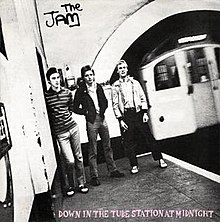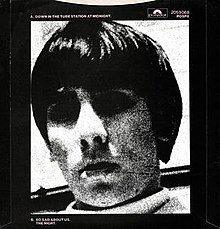Down in the Tube Station at Midnight
| "Down in the Tube Station at Midnight" | ||||
|---|---|---|---|---|
 | ||||
| Single by the Jam | ||||
| from the album All Mod Cons | ||||
| B-side | "So Sad About Us / The Night" | |||
| Released | 13 October 1978 | |||
| Recorded | 7 August 1978 | |||
| Studio | RAK Studios, London | |||
| Genre | Mod revival | |||
| Label | Polydor (UK) | |||
| Songwriter(s) | Paul Weller | |||
| Producer(s) | Vic Coppersmith-Heaven | |||
| The Jam singles chronology | ||||
| ||||
| Back cover | ||||
 Keith Moon, who died shortly before the single's release | ||||
"Down in the Tube Station at Midnight" is a single by the Jam, and was the second single from their third album, All Mod Cons. Released in October 1978, it reached No. 15 on the UK Singles Chart.[1] The single was backed by a cover version of the Who's song "So Sad About Us", and the song "The Night", written by Bruce Foxton.
Production
[edit]Originally, Paul Weller had wanted to exclude the song from the All Mod Cons album,[2] on the grounds that the arrangement had not sufficiently developed during the recording sessions.[3] He was persuaded to include it by the record's producer Vic Coppersmith-Heaven.[3][4] The song was recorded on 7 August 1978 at RAK Studios in London together with "Mr. Clean", "In The Crowd" and "The Place I Love", all of which also appeared on All Mod Cons.[5]
Lyrical theme and musical composition
[edit]The song tells the story of an unnamed narrator travelling on his own who enters a London Underground tube station at midnight to get the last train home, where he is attacked by a gang of men who 'smell like pubs, and Wormwood Scrubs, and too many right-wing meetings' as he buys a ticket from an automated machine.[6] The song starts with the atmospheric sounds of a London Underground station, then a tense, syncopated beat carried by the bass guitar. The lyrics are sentimental, contrasting the warmth of home and domestic life with the dangers of 1970s London's urban decay and casual late-night violence. Tension is heightened by a heartbeat audio effect in the left stereo channel at points during the song.[7]
The sound of an Underground train at the beginning and end of the song was recorded at St John's Wood Station.[6]
Cover art
[edit]The front cover photograph was taken at Bond Street tube station, on the westbound Central line. On the back cover was a portrait photograph of Keith Moon who had died a month prior to the single's release.[8] The Who's "So Sad About Us" was included as a tribute to Moon.[9]
Certifications
[edit]| Region | Certification | Certified units/sales |
|---|---|---|
| United Kingdom (BPI)[10] | Silver | 200,000‡ |
|
‡ Sales+streaming figures based on certification alone. | ||
References
[edit]- ^ "Artists - The Jam". Rolling Stone. 8 November 2001. Archived from the original on 8 October 2012. Retrieved 7 November 2020.
- ^ Alexander, Phil (12 August 2013). "The Jam: All Mod Cons Revisited". Mojo. Retrieved 7 November 2020.
- ^ a b Buskin, Richard (1 March 2007). "Classic Tracks: The Jam 'The Eton Rifles'". Sound on Sound. Retrieved 7 November 2020.
- ^ "How The Jam almost didn't record one of their biggest hits". Radio X. Retrieved 2 November 2020.
- ^ Hewitt 1997, CD tray insert.
- ^ a b "Down in the Tube Station at Midnight by The Jam". Songfacts. Retrieved 7 November 2020.
- ^ Taysom, Joe Taysom·6 October 2020 (6 October 2020). "The reason why the BBC banned The Jam's anti-racism song 'Down in the Tube Station at Midnight'". Far Out. Retrieved 7 November 2020.
{{cite web}}: CS1 maint: numeric names: authors list (link) - ^ "Down in the Tube Station at Midnight". Snapgalleries.com. 19 April 2016. Retrieved 7 November 2020.
- ^ "The Jam - Down in the Tube Station at Midnight". Radio X. Retrieved 7 November 2020.
- ^ "British single certifications – Jam – Down in the Tube Station at Midnight". British Phonographic Industry. Retrieved 13 October 2023.
Sources
[edit]- Hewitt, Paolo (1997). Direction, Reaction, Creation (CD). United Kingdom: Polydor. 537143-2.
